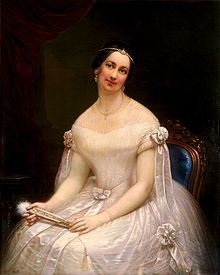Julia Gardiner Tyler | |
|---|---|
 Official portrait, 1844 | |
| 14th First Lady of the United States | |
| In role June 26, 1844 – March 4, 1845 | |
| President | John Tyler |
| Preceded by | Priscilla Cooper Tyler (acting) |
| Succeeded by | Sarah Childress Polk |
| Personal details | |
| Born | Julia Gardiner May 4, 1820 Gardiner's Island, New York, U.S. |
| Died | July 10, 1889 (aged 69) Richmond, Virginia, U.S. |
| Resting place | Hollywood Cemetery, Richmond, Virginia, U.S. |
| Spouse | |
| Children | 7 |
| Parent(s) | David Gardiner Juliana MacLachlan |
| Signature | |
Julia Gardiner Tyler (née Gardiner; May 4, 1820 – July 10, 1889) was the fourteenth first lady of the United States from June 26, 1844, to March 4, 1845, as the second wife of President John Tyler. A member of the influential Gardiner family, she had many notable figures as suitors. She met the recently widowed President Tyler in 1842, and she agreed to marry him after he comforted her in the aftermath of her father's death. They married in secret, and she became first lady immediately upon their marriage, serving in the role for the final eight months of his presidency.
Tyler was delighted with her role as first lady, redecorating the White House and establishing her own "court" of ladies-in-waiting to mimic the practices of European monarchies that she had visited years before. She also established the tradition of playing "Hail to the Chief" when the president arrived at an event, and she popularized the waltz and polka dances in the United States. Tyler was a fierce advocate for her husband's political priorities, organizing social events to lobby Congressmen, particularly for the Texas annexation. She is credited with revitalizing the position of first lady, both socially and politically, after several inactive first ladies before her.
After leaving the White House, Tyler moved to the Sherwood Forest Plantation in Virginia with her husband and had seven children. She became a prominent supporter of slavery in the United States, writing an influential pamphlet in 1853 that defended the practice. During the American Civil War, she provided support to the Confederate States of America, creating a permanent rift with her family in New York. After the war, she was involved in a legal dispute regarding her mother's estate with her brother, who had been a loyal Unionist. Tyler returned to Washington in the 1870s as her reputation recovered, assisting first lady Julia Grant at the White House and convincing Congress to provide a pension for widowed first ladies. She spent her final years in Richmond, Virginia, where she lived in poor health. She died of a stroke on July 10, 1889, in the same hotel where her husband had died from the same illness 27 years before.